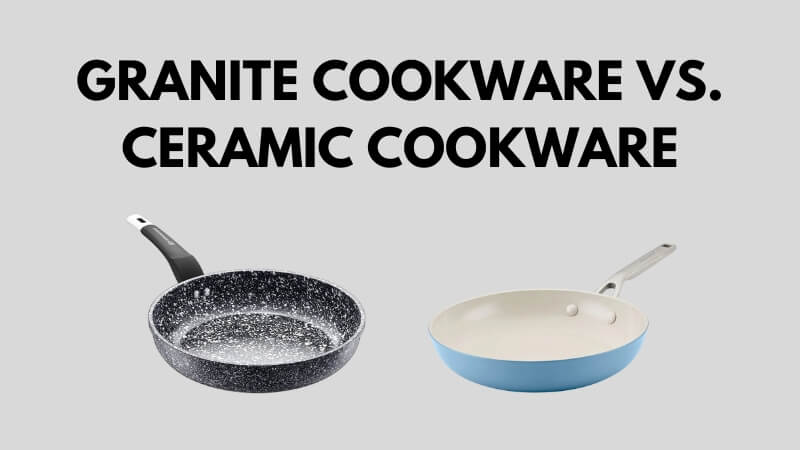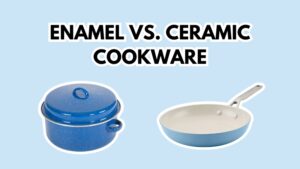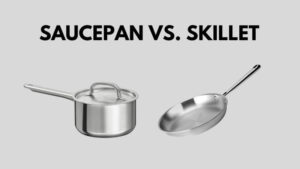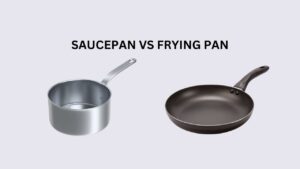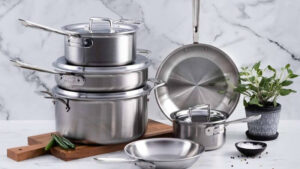The cooking utensils you pick can make all the difference in your kitchen, affecting everything from how your food cooks to how easy it is to clean up afterward. Granite and ceramic cookware are two widely sought-after options, each offering its own set of benefits.
So which one is better? Decide for yourself once you know the key differences.
Comparison granite cookware vs ceramic cookware
| Granite | Ceramic |
|---|---|
| Typically made of a core material like aluminum or steel | Made from natural clay that is hardened and coated with a glaze |
| Resists scratches and wear and tear | Prone to cracking and chipping |
| Heats up quickly and distributes heat evenly | Takes longer to heat up but maintains consistent temperatures for extended periods |
| More affordable | Expensive upfront |
To find your perfect match in the kitchen, you will have to know the answer to, “What is the difference between ceramic and granite cookware?” Let’s start there!
Construction
Granite utensil is typically made of a core material like aluminum or steel. It is coated with a layer of enamel that gives it a granite-like appearance. It is usually speckled with tiny flecks of white, grey, or black, creating a dappled effect.
But despite its name, it doesn’t actually contain granite. The enamel coating is non-stick, so cooking and cleaning is a lot more convenient. It is smooth to touch, typically glossy or semi-matte.
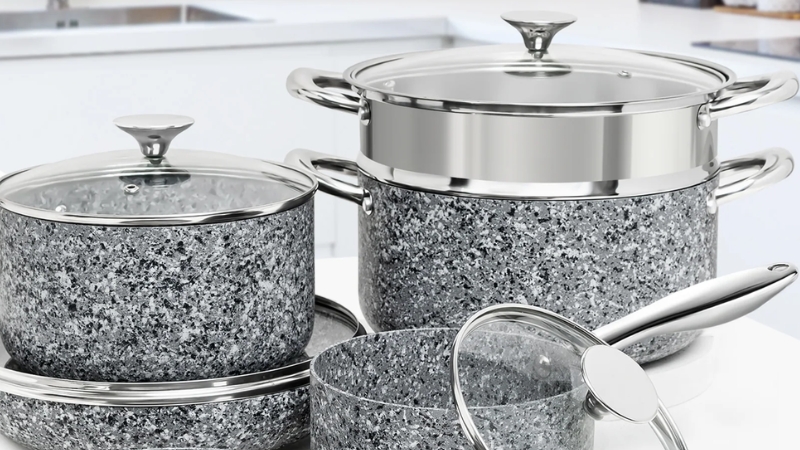
On the other hand, ceramic utensil is made from natural clay that is hardened and coated with a glaze. This is sometimes referred to as solid ceramic cookware. There is another type called ceramic-coated cookware, which has an aluminum metal core. Often, it is seen as the cheap alternative. Like granite one, its coating is non-stick.
Durability
Granite utensil is generally considered durable, thanks to its robust construction. Its tough coating resists scratches, as well as wear and tear. However, dropping granite and using metal utensils can still chip the coating. High-quality granite cookware, especially from reputable brands, tends to have better durability.
Ceramic utensils, while also durable, are more prone to damage than granite ones. Its glaze can crack and chip if not handled carefully. Moreover, the non-stick surface of ceramic cookware can wear out with frequent use. Investing in well-made ceramic pots and pans can help extend its lifespan, but it generally requires a gentler touch.
Heat distribution and retention
Granite cookware, with its core material, heats up quickly and distributes heat evenly across the surface. So, it is perfect for tasks where consistent heat is crucial, like frying or sautéing. However, granite material doesn’t retain heat as effectively once it is off the stove. This can get in the way of dishes that require prolonged warmth.
In contrast, ceramic cookware excels in heat retention. It takes slightly longer to heat up but maintains consistent temperatures for extended periods, making it perfect for slow cooking and simmering. Its even heat distribution ensures that food cooks uniformly, reducing the risk of hot spots and burnt edges.
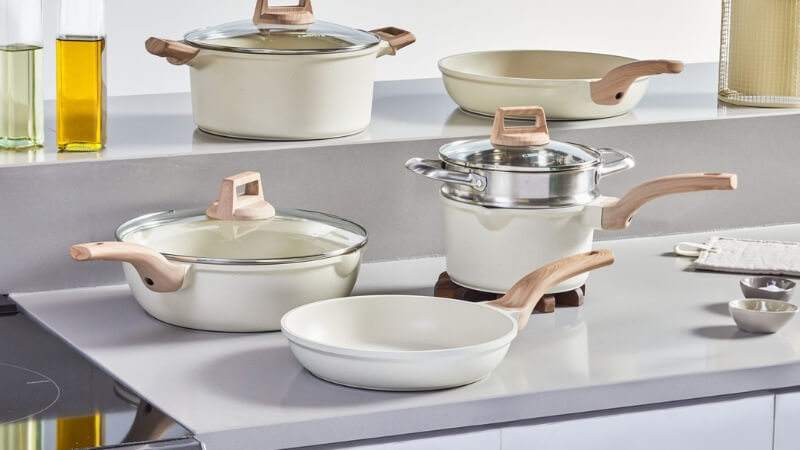
Price
When it comes to the price, granite is generally seen as the more affordable option. The materials used in granite utensils tend to keep production costs lower, making it budget-friendly. Nonetheless, there are higher-end granite options with advanced features like reinforced coatings that come at a premium price.
Ceramic pots and pans often carry a higher price tag, especially if it is from a well-known brand. The production process for ceramic cookware can drive up the cost. But like granite, there is a wide range of prices within the ceramic cookware category.
Whether you lean towards granite or ceramic, it is possible to find a quality product at a price that works for you.
Read more: Saucepan vs Saucepot: Everything You Need to Know
User experience
Users often praise granite cookware for its sophisticated stone-like appearance. It also heats up quickly, making it great for tasks that require fast temperature changes. Plus, its non-stick surface means less fat and oil and easy-peasy cleaning after cooking. However, some users have reported a slight odor that can linger, especially if the cookware is overheated.
Ceramic cookware stands out for its wide array of color options, allowing it to fit seamlessly with different kitchen styles. It is particularly valued for cooking delicate items like eggs, fish, and chicken, where only a bit of oil or fat is needed. Ceramic cookware is also excellent for reheating leftovers, as it provides even heat distribution without drying out the food. But one downside is that ceramic cookware is more prone to chipping and cracking. It is important to let it cool before cleaning or storing it to avoid thermal shock, which can lead to damage.
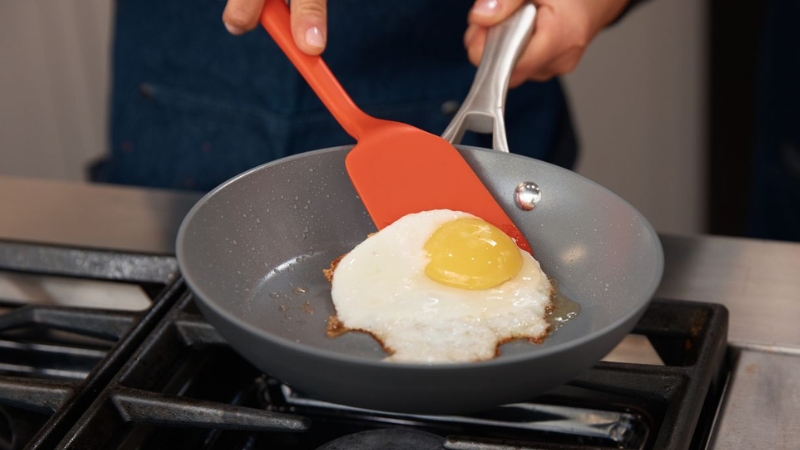
Is granite/ceramic cookware safe?
One of the most important factors to consider when purchasing cooking utensils is safety, and both granite and ceramic cookware have earned a reputation for being safe when used correctly.
Granite cookware, which features an aluminum or steel core with an enamel coating, is often free of harmful chemicals like PTFE and PFOA. Therefore, compared to traditional non-stick cookware, it is a safer choice.
However, it is essential to ensure that the enamel coating is free of lead or cadmium, which can sometimes be found in lower-quality products. Always look for cookware that is certified to be free of these substances for added peace of mind.
Ceramic cookware is widely regarded as one of the safest utensils options available. Made from natural materials, ceramic is free of synthetic chemicals and toxins. It is often the go-to option for health-conscious cooks.
However, as with granite cookware, it is necessary to choose ceramic ones that doesn’t have lead and cadmium. A lot of the time, these can be found in low-quality and poorly made products.
In both cases, choosing well-made utensils from reputable brands is key to ensuring safety in the kitchen. As long as you use and take care of your cookware properly, both granite and ceramic options are safe.
Conclusion
To conclude the granite vs ceramic cookware dilemma, both offer unique benefits, making them suitable for different cooking needs and preferences. Granite cookware is great for those seeking affordability, quick heating, and durability, while ceramic one is better for those who prioritize heat retention and aren’t too restricted, budget-wise. By considering the factors that matter most to you, you will be able to choose the right cookware.

